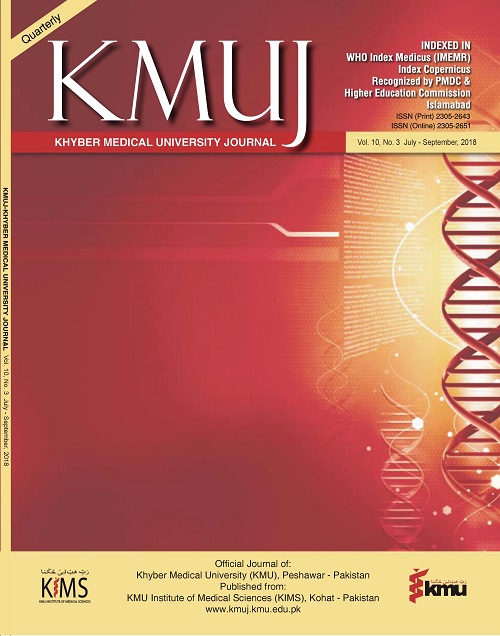SILENCE MISDIAGNOSED: MUTISM, AUTISM OR SUBMISSIVENESS? DIAGNOSTIC BIAS IN COLLECTIVISTIC CULTURE
Main Article Content
Abstract
ABSTRACT
Selective Mutism (SM) is a rare condition which is even rarer in collectivistic cultures. Firstly, SM is most often mistaken/misdiagnosed as autism spectrum disorder (ASD) and other related conditions due to lack of awareness of SM and the presence of mimicking characteristics of autistic behaviors in SM. Secondly, submissive behaviors in collectivistic societies further veil this rare condition by considering SM rather desirable than a problem. Especially in situations where developmental delay is a comorbid condition it became a great challenge to correctly diagnose among related conditions. We had a twelve years old girl with developmental delays who remained falsely diagnosed with ASD for five years. We have highlighted the diagnostic issues in SM and other related conditions especially ASD that might hinder the development of an appropriate management plan. The study also emphasized the need to develop a standardized assessment tool to diagnose SM considering cultural aspects into account.
KEY WORDS: Selective Mutism (MeSH); Autism Spectrum Disorder (MeSH); Submissiveness (Non-MeSH); Developmental delays (Non-MesH); Collectivistic culture (Non-MeSH)
Article Details
Work published in KMUJ is licensed under a
Creative Commons Attribution 4.0 License
Authors are permitted and encouraged to post their work online (e.g., in institutional repositories or on their website) prior to and during the submission process, as it can lead to productive exchanges, as well as earlier and greater citation of published work.
(e.g., in institutional repositories or on their website) prior to and during the submission process, as it can lead to productive exchanges, as well as earlier and greater citation of published work.
References
REFERENCES
Sharkey L, McNicholas F. More than 100 years of silence, elective mutism. Eur Child Adolesc Psychiatry 2008;17(5):255-63. DOI: 10.1007/s00787-007-0658-4
American Psychiatric Association. Diagnostic and statistical manual of mental disorders. 5th ed. Washington, DC: American Psychiatric Publishing; 2013.
Sharp WG, Sherman C, Gross AM. Selective mutism and anxiety: A review of the current conceptualization of the disorder. J Anxiety Disord 2007;21(4):568-79. DOI: 10.1016/j.janxdis.2006.07.002
Wong P. Selective mutism: a review of etiology, comorbidities, and treatment. Psychiatry (Edgmont) 2010;7(3):23-31.
Kehle TJ, Madaus MR, Baratta VS, Bray MA. Augmented self-modeling as a treatment for children with selective mutism. J Sch Psychol 1998;36(3):247-60. DOI: 10.1016/S0022-4405(98)00013-2
Ahmad S, Mahmood Z. Differential diagnosis of Autism and Mental Retardation: issues and possible solutions. FWU J Soc Sci 2011;5(1):16-33.
Gudiño OG, Lau AS. Parental cultural orientation, shyness, and anxiety in Hispanic children: An exploratory study. J Appl Dev Psychol 2010;31(3):202-10.
Chen X, DeSouza AT, Chen H, Wang L. Reticent behavior and experiences in peer interactions in Chinese and Canadian children. Dev Psychol 2006; 42(4):656. DOI: 10.1037/0012-1649.42.4.656
Kristensen H. Selective mutism and comorbidity with developmental disorder/delay, anxiety disorder, and elimination disorder. J Am Acad Child Adolesc Psychiatry 2000;39(2):249-56. DOI: 10.1097/00004583-200002000-00026
Alpaslan AH, Koçak U, Coşkun K Ş Çobanoğlu C. A case of severe long-term selective mutism in a child with intellectual disability. Int J Dev Disabil 2016;62(2):131-5. DOI: 10.1179/2047387715Y.0000000003.
Shipon-Blum E. When the words just won’t come out: Understanding selective mutism. The Selective Mutism Group Childhood Anxiety Network (SMG-CAN) 2007. [Cited on: March 10 2018]. Accessed from: http://www.arnoldpalmerhospital.com/~/media/files/practices/neuropsychology-consultants-aph/selective-mutism2.pdf.
Schopler E, Reichler RJ, Renner BR. The childhood autism rating scale (CARS). Los Angeles, CA: Western Psychological Services; 2002.
Bluma SM, Searer MS, Frohman AH, Hilliard JM. Portage guide to early education- revised edition. Portage, Wisconsin: Cooperative Educational Service Agency; 1976.
Koppitz EM. The Bender gestalt test for young children. Harcourt Health Sciences Group 1963.
Koppitz EM. The Bender gestalt test for young children: research and applications. New York, NY: Grune & Stratton; 1975.
Stigler SM. Darwin, Galton and the statistical enlightenment. J R Stat Soc Series A (Statistics in Society). 2010;173(3):469-82.
Colvin L, Jurenka SB, Van Allen MI. Down syndrome. In: Hisami FM, Weissman SM, Martin G, editors. , editors. Chromosomal instability and aging. New York: Marcel Dekker; (2003). p. 441–63.
Moore DG, Oates JM, Hobson RP, Goodwin J. Cognitive and social factors in the development of infants with Down syndrome. Downs Syndr Res Pract 2002;8(2):43-52.
Girimaji SC. Clinical practice guidelines for the diagnosis and management of children with mental retardation. Indian J Psychiatry 2008;132(1):43-67.
